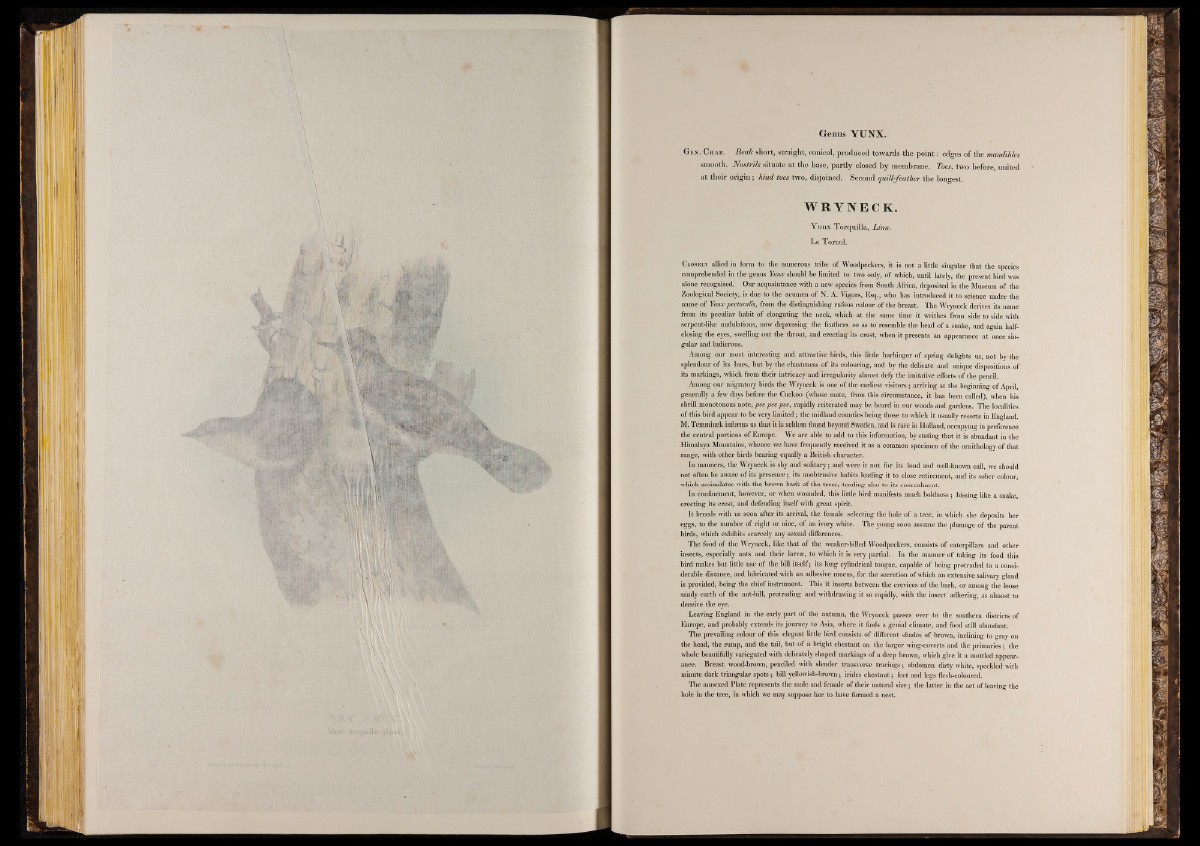
Genus YUNX.
Gen. Char. B e a k short, straight, conical, produced towards the point: edges of the mandibles
smooth. N o strils situate a t the base, partly closed by membrane. Toes, two before, united
at the ir o rig in ; hind toes two, disjoined. Second quill-feather the longest.
WR Y N E C K .
Y u n x Torquilla, Linn.
Le Torcol.
C l o s e l y allied in form to the numerous tribe of Woodpeckers, it is not a little singular that the species
comprehended in the genus Yunx should be limited to two only, o f which, until lately, the present bird was
alone recognised. Our acquaintance with a new species from South Africa, deposited in the Museum of the
Zoological Society, is due to the acumen of N. A. Vigors, Esq., who has introduced it to science under the
name of Yunx pectoralts, from the distinguishing rufous colour of the breast. The Wryneck derives its name
from its peculiar habit of elongating the neck, which at the same time it writhes from side to side with
serpent-like undulations, now depressing the feathers so as to resemble the head of a snake, and again halfclosing
the eyes, swelling out the throat, and erecting its crest, when it presents an appearance at once singular
and ludicrous.
Among our most interesting and attractive birds, this little harbinger of spring delights us, not by the
splendour o f its hues, but by the chasteness of its colouring, and by the delicate and unique dispositions of
its markings, which from their intricacy and irregularity almost defy the imitative efforts o f the pencil.
Among our migratory birds the Wryneck is one of the earliest visitors; arriving at the beginning o f April,
generally a few days before the Cuckoo (whose mate, from this circumstance, it has been called), when his
shrill monotonous note, pee pee pee, rapidly reiterated may be heard in our woods and gardens. The localities
of this bird appear to be very limited; the midland counties being those to which it usually resorts in England.
M. Temminck informs us that it is seldom found beyond Sweden, and is rare in Holland, occupying in preference
the central portions of Europe. We are able to add to this information, by stating that it is abundant in the
Himalaya Mountains, whence we have frequently received it as a common specimen of the ornithology of that
range, with other birds bearing equally a British character.
In manners, the Wryneck is shy and solitary; and were it not for its loud and well-known call, we should
not often be aware o f its presence; its unobtrusive habits leading it to close retirement, and its sober colour,
which assimilates with the brown bark o f the trees, tending also to its concealment.
In confinement, however, or when wounded, this little bird manifests much boldness; hissing like a snake,
erecting its crest, and defending itself with great spirit.
It breeds with us soon after its arrival, the female selecting the hole o f a tree, in which she deposits her
eggs, to the number of eight or nine, o f an ivory white. The young soon assume the plumage of the parent
birds, which exhibits scarcely any sexual differences.
The food of the Wryneck, like that of the weaker-billed Woodpeckers, consists o f caterpillars and other
insects, especially ants and their larvae, to which it is very partial. In the manner o f taking its food this
bird makes but little use o f the bill itself; its long cylindrical tongue, capable of being protruded to a considerable
distance, and lubricated with an adhesive mucus, for the secretion o f which an extensive salivary gland
is provided, being the chief instrument. This it inserts between the crevices of the bark, or among the loose
sandy earth o f the ant-hill, protruding and withdrawing it so rapidly, with the insect adhering, as almost to
deceive the eye.
Leaving England in the early part of the autumn, the Wryneck passes over to the southern districts of
Europe, and probably extends its journey to Asia, where it finds a genial climate, and food still abundant.
The prevailing colour of this elegant little bird consists o f different shades of brown, inclining to gray on
the head, the rump, and the tail, but of a bright chestnut on the larger wing-coverts and the primaries; the
whole beautifully variegated with delicately shaped markings of a deep brown, which give it a mottled appearance.
Breast wood-brown, penciled with slender transverse tracings; abdomen dirty white, speckled with
minute dark triangular spots; bill yellowish-brown; irides chestnut; feet and legs flesh-coloured.
The annexed Plate represents the male and female of their natural size; the latter in the act of leaving the
hole in the tree, in which we may suppose her to have formed a nest.